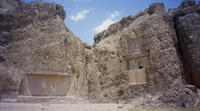
Iran - Ancient wonders
Photo. An ancient wonder in Iran. © Travel Explorations.
Iran is home to some of the most incredible ancient wonders in the world, reflecting its rich history and diverse cultures. Iran, historically known as Persia, is one of the world's oldest continuous civilizations, with human settlements dating back over 7,000 years. This deep historical timeline means that Iran has been home to multiple empires, each leaving behind a legacy of incredible monuments, cities, and artifacts. Iran's empires, such as the Achaemenid, Parthian, and Sassanian, were some of the most powerful in the ancient world. The architectural and cultural achievements of these empires influenced neighboring regions and left a lasting impact on global history.
Here are some of the most remarkable ancient wonders in Iran:
1. Persepolis
Location: Near Shiraz
Significance: Founded by Darius the Great in 518 BCE, Persepolis was the ceremonial capital of the Achaemenid Empire. The site is famous for its grand palaces, intricate bas-reliefs, and monumental staircases. The ruins of Persepolis, with their detailed carvings depicting various delegations bringing tribute to the king, provide a glimpse into the splendor of the Persian Empire.
2. Naqsh-e Rustam
Location: Near Persepolis, Fars Province
Significance: This ancient necropolis is home to the tombs of several Achaemenid kings, including Darius the Great and Xerxes I. The site also features impressive rock reliefs depicting scenes of royal conquests and religious rituals, carved into the cliff face. The grandeur and scale of the tombs make Naqsh-e Rustam a must-see for anyone interested in ancient Persian history.
3. Pasargadae
Location: Fars Province
Significance: Pasargadae was the first capital of the Achaemenid Empire and the final resting place of Cyrus the Great, the founder of the empire. The most iconic structure at Pasargadae is the Tomb of Cyrus, a simple yet powerful monument that reflects the founder's legacy. The site also includes ruins of palaces, gardens, and a Zoroastrian fire temple.
4. Chogha Zanbil
Location: Khuzestan Province
Significance: Chogha Zanbil is one of the best-preserved ziggurats outside of Mesopotamia and a UNESCO World Heritage site. It was built by the Elamite king Untash-Napirisha around 1250 BCE as a temple complex dedicated to the god Inshushinak. The massive structure, originally standing over 50 meters high, is an impressive example of ancient Elamite architecture.
5. Shahr-e Sukhteh (Burnt City)
Location: Sistan and Baluchestan Province
Significance: Shahr-e Sukhteh, dating back to 3200 BCE, is an ancient city that was mysteriously abandoned in the Bronze Age. It is considered one of the most advanced urban settlements of its time, with evidence of early urban planning, a complex irrigation system, and remarkable artifacts, including the world’s oldest known artificial eyeball and a backgammon set.
6. Bisotun Inscription
Location: Kermanshah Province
Significance: The Bisotun Inscription is a massive rock relief and cuneiform inscription created by Darius the Great around 520 BCE. It recounts Darius's rise to power and his subsequent victories over rival claimants to the throne. The inscription, carved high on a cliff face, is often compared to the Rosetta Stone for its linguistic importance, as it helped scholars decipher cuneiform script.
7. Takht-e Soleyman
Location: West Azerbaijan Province
Significance: Takht-e Soleyman is a significant Zoroastrian religious site that dates back to the Sassanian era. The site includes the remains of a Zoroastrian fire temple and a royal sanctuary, built around a sacred lake. The complex is surrounded by a fortified wall, and its mystical setting in the mountains adds to its awe-inspiring atmosphere.
8. Tombs of the Kings at Susa
Location: Khuzestan Province
Significance: Susa was an ancient city that served as one of the main capitals of the Achaemenid Empire. The Tomb of Daniel, the biblical prophet, is located here, along with other significant archaeological remains, including palaces and the famous Apadana (audience hall) built by Darius the Great.
These ancient wonders of Iran offer a fascinating journey through the country's rich history, showcasing the architectural, cultural, and artistic achievements of its various civilizations. Each site provides a unique glimpse into the ancient world and the enduring legacy of Iran's past.
Some lesser-known ancient wonders of Iran offer a deeper insight into the diverse cultural and historical tapestry of the country, each with its own unique story and architectural significance.
While some sites like Persepolis are well-known, many ancient Iranian wonders remain lesser-known and less explored by the general public. This sense of discovery adds to their allure, as visitors can feel like they are uncovering hidden treasures. Many of Iran's ancient wonders are connected to legends, myths, and religious stories that add layers of mystique. For example, the Tomb of Cyrus the Great is not just a burial site but a symbol of leadership and justice that resonates through history.
Some of the lesser-known ancient wonders are:
- Gonbad-e Qabus in the Golestan Province, is a 72-meter tall tomb tower built in 1006 AD during the Ziyarid dynasty. It is one of the tallest brick towers in the world and is an outstanding example of Islamic architecture.
- Babak Castle (Ghaleh Babak) in the East Azerbaijan Province: built on a mountain top at an altitude of over 2,300 meters, Babak Castle was a stronghold of Babak Khorramdin, a Persian revolutionary leader who resisted Arab rule in the 9th century.
- Soltaniyeh Dome located in the Zanjan Province. The Dome of Soltaniyeh, built in the early 14th century, is one of the largest brick domes in the world. It was constructed under the orders of the Ilkhanid ruler Öljeitü and serves as his mausoleum. The dome is notable for its innovative structural design and the exquisite tilework that decorates its interior.
Exploring these sites provides a more comprehensive understanding of Iran’s ancient civilizations beyond the most famous landmarks.
The ancient wonders of Iran are fascinating because they offer a rich, multi-layered understanding of human civilization, combining architectural brilliance, artistic mastery, religious depth, and historical significance. They are gateways to a world that shaped much of human history, providing insights into the development of culture, religion, and art across millennia.
Stein Morten Lund, August 2024
Additional information
Read more about unique adventures in Iran on our travel guide Travel Explorations.












